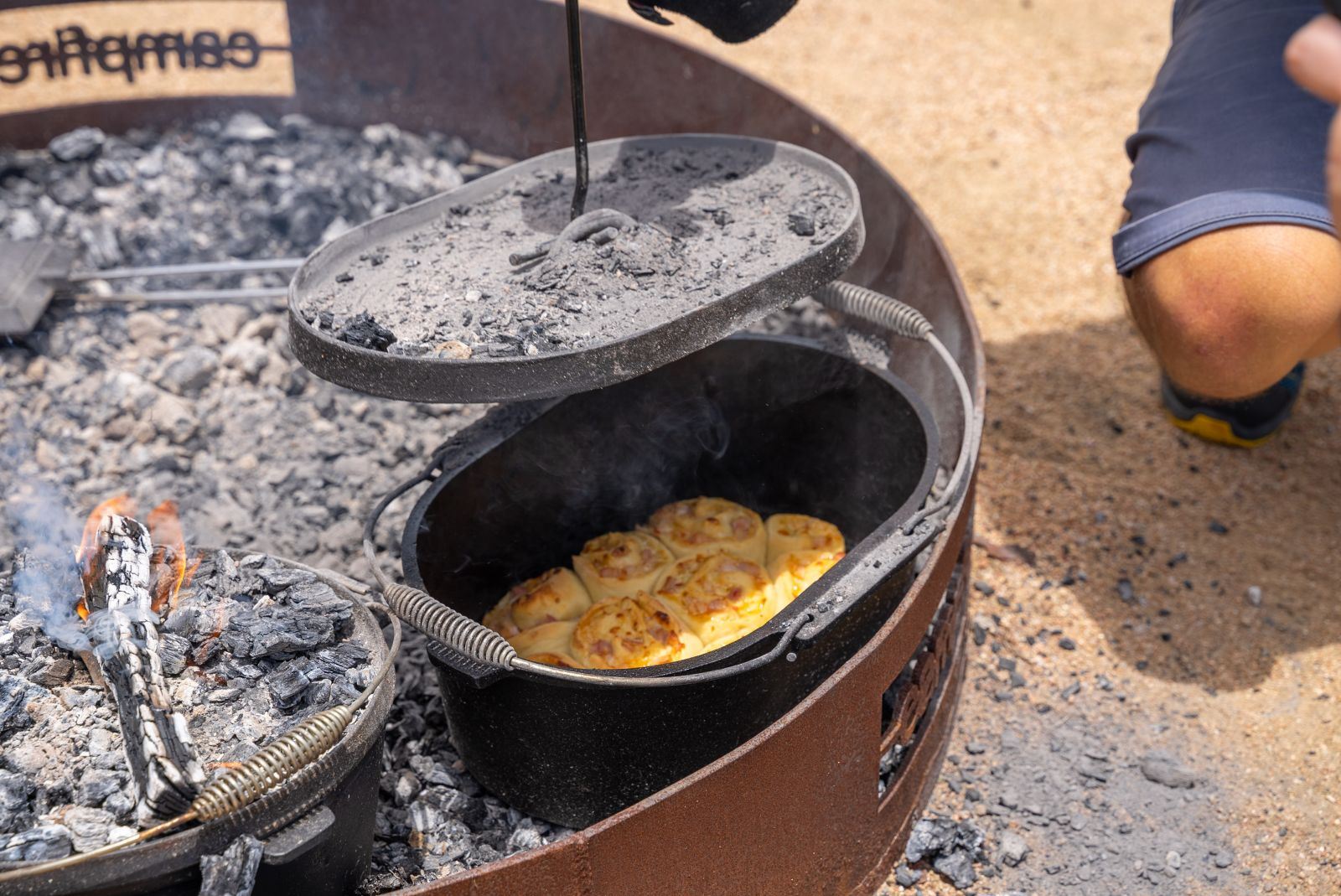
You might have seen the new craze on Instagram or Tik Tok about cooking with camp ovens in the bush, but the fact is camp ovens have been around for centuries and baking bread in the middle of nowhere, isn’t a new trend. Cooking with gas has become more popular because of its convenience to cook anywhere and in any condition.
A portable gas oven and stove gives you the choice to cook any dish you would usually cook in an oven at home. The benefits of this are just plugging into gas, setting a timer and waiting for your food to cook evenly. Camp ovens are little more involved but ask any camper, the act of building a campfire and producing something that you’ve worked hard for greatly outweighs the convenience of cooking with an appliance. There really is nothing like cooking on a fire, so in this article we are going to talk about how to clean a camp oven vs how to ‘season’ a camp oven and the critical difference between gas and fire.
-
Which camp oven is right for you?
Cast iron, although it does take much longer to heat up, once at temperature you’re able to take it off the heat and it will keep cooking because of the great heat retention of the material. Spun steel does require a little more attention whilst cooking because it does get hot quickly but only on one side, so it's best to turn towards the heat more often for a more even heat. This method is good for simple meals, but if you are cooking with top and bottom heat it can be great for a much bigger range of cooking styles. If you managed to bring with you a campfire tripod for cooking, we highly recommend this technique as you don’t have to keeping turning the pot, you can just add fire to underneath and coals to on top of the lid as you please. The best thing about a camp oven is its versatility. A camp oven is usually for cooking meals that require a slow heat to bring the best flavour out, but with a spun steel pot you can flip over the lid onto some hot coals and use it as a searing plate for steaks or veggies that you’d like to grill rather than slow roast. Cooking with a gas oven, it usually takes about 15 minutes to get a cast iron pan hot enough to sear a steak, so if you're looking to travel lightly a camp oven pot might be for you.
One tip people tend to learn the hard way, is that you must be very careful not to drop a cast iron pot or pan. They do crack, as their structural integrity is not the same as steel. A spun steel pot will bend or dent if it is dropped but the benefit of this is you can usually buff it back out.
-
How big do I need my camp oven to be?
Camp ovens come in a range of sizes from 2 quarts all the way up to 12 quarts. A good way to understand the sizing is to know that 1 quart is equal to 1.13L. So, if you’re going solo through the bush 2 quarts will likely be enough for 1 meal, depending on how you like to eat. As a rule, if you are going to cook stew, it’s best to leave at least 2-3cm of space between the lid and the broth, just like you would at home, this is to keep the liquid from boiling over. If you are feeding a family of 5 it’s best to go bigger and save leftovers rather than having to ration.
-
Can you build campfires where you intend on travelling to?
Many national parks and beaches have a no campfire rule to minimise the risk of bush fires in peak season. It’s important to check with the park rangers or read signs carefully before building a fire. If you are unsure, following fire etiquette by bringing your own firewood, not damaging native bush land and pouring water on it before going to bed is a great way to minimise risk. If you are in a holiday park or tourist area, it’s best to check with reception about cooking with campfires first. If you can carry a fire pit with you, even better. Leaving no trace is always the aim when enjoying the great outdoors.
-
What are the rules when cooking with gas?
90% of campers will choose to cook with gas because it is simply more convenient. However, storing gas comes with a lot more rules and regulations. Storing gas requires ventilation or mounting to the outside of a motorhome. It needs to be stored in a sealed box that can be accessible from the outside of a caravan or RV. It is extremely dangerous to store a gas bottle in a hot car or any enclosed space that isn’t well ventilated. Minor gas leaks are undetectable to us, so it’s important store them correctly to avoid any accidents. The benefits of cooking with gas are instant heat and that's why many campers prefer to carry both options. Building a decent fire takes some practice and there won’t always be the most ideal conditions if it’s windy or raining. So, cooking with gas is a sure-fire way to have a hot meal any day.
-
How to season and clean a camp oven?
A lot of camp stoves will come pre-seasoned. However, if yours is looking a little worse for ware and it has started to rust, it’s probably because it’s been left to sit in the rain or a moist area. Cast iron shouldn’t rust if it has been seasoned properly, so there really should never be any reason to use water and soap on a camp oven. If it is rusting, it’s okay to scrub down with soap and water until it looks like it did before. Cast iron camp ovens are designed to retain flavour, so if you use a lot of soap you might end up with that chemical taste in your next dish. Try to avoid soap if you can, but for particularly rusty pans a little is okay. After this, it’s crucial to completely dry the clean pot before seasoning, as water and oil aren’t friends.
The difference between spun steel and cast iron when it comes to cleaning is the time needed for seasoning after it is cleaned. Spun steel will heat up on a campfire and burn off excess water within 10 minutes. A cast iron pot will take significantly longer to burn off water so keep this in mind when packing up the next day. The next crucial thing to remember is which oil to use. Any low smoke oils like canola, vegetable, rice bran, avocado or peanut oil will do the trick because of their low-fat contents. Fat is what burns and creates smoke. Do not use olive oil, cold pressed or raw oils as they will burn rather than coat your pot with flavour and if you’ve popped your camp oven in the oven at home to season, you could end up smoking the place out.
It’s ok to use spare clothes or paper towels to apply a thin layer of oil to every surface, wait until it has stopped smoking as much and then add another layer. It’s important to coat every surface to avoid rust damage and fire damage to the outside of your camp stove. If bubbles start to appear than it’s time to wipe down and thin out the layer of oil, bubbles will create holes in your seasoning where food will get stuck to and burnt. For the best results and flavour, do 2-3 layers of seasoning on the lid and the pot, inside and out. A much easier way of doing this process is by sticking it in the oven or BBQ on the hottest temperature you can. The best seasoning is done at higher temperatures. If you are going to do this in the oven, it’s a good idea to coat your entire home oven with a low smoke oil, it will still smoke a lot so turn on all your extractor fans and open the windows. To avoid this, using the BBQ outside will save you from smoking out the house.
-
How to cook with a Dutch oven or camp oven?
Depending on what you’ve chosen to cook with, that being cast iron or spun steel, the results of anything you cook will vary. It’s a well-known fact that cast iron will hold seasoning much better than spun steel so if you are going to boil liquid, cast iron will come out as the better choice if you want to avoid the little black elements you often see in spun steel. Cooking with liquids will strip the seasoning faster on a pot regardless, so it just depends on how often you would like to season your pots. Depending on the seal of your camp oven lid, if it is loose, more liquid will burn off and for stews it just means adding more stock. If it is tight, it will have a louder sound as the compression pushes against the steel to escape but will ensure all the steam and liquid is contained for shorter cooking times. A camp stove lid that has a lip will be able to hold coals on top, so have a look out for this when considering which camp stove is best for you to purchase. Cooking with coals on top is great for an even heat, which is required for things like fresh bread, dumplings or roasts.
When checking on the progress of your meal, lifting a lid can be dangerous without the right design or safety gear. A double handle will help keep the pot more evenly stable when lifting off and to be safe a decent oven mitt holding it on one side will also help stabilize and avoid spills.
-
How much do they weigh?
Cast iron is significantly heavier than spun steel, however cast-iron camp stove to tend to produce the best flavour and cooking results. Kind of like your slow cooker at home, the flavour is more prominent and textured. It really does depend on how much weight you can afford to carry versus how passionate you are about cooking. It might even be worth carrying both, so you have the option of cooking faster, but the best way is to test it for yourself. If you have a decent awning, you can make a fire anywhere and practice your cooking skills in any climate. Safety is the number one concern when it comes to making a meal on an open flame. If you're looking for the ultimate starter pack, check out the Camp Oven Set 9-quart duo lid pack.
The most important part of cooking with a campfire is to experience something different. When you get outdoors, it’s possible to break free of your normal routine and there really is nothing like bonding with your mates over who burnt dinner. Best of all campfires are a free source of heat and when dealt with correctly, they have very little impact of the environment. It’s best to do your own research on how to build the best fire to cook with, but hot coals will do a better job of cooking than a naked flame as they store more heat, so get out there and try it!
By: Jessica Pritchard


.png)
Leave a comment